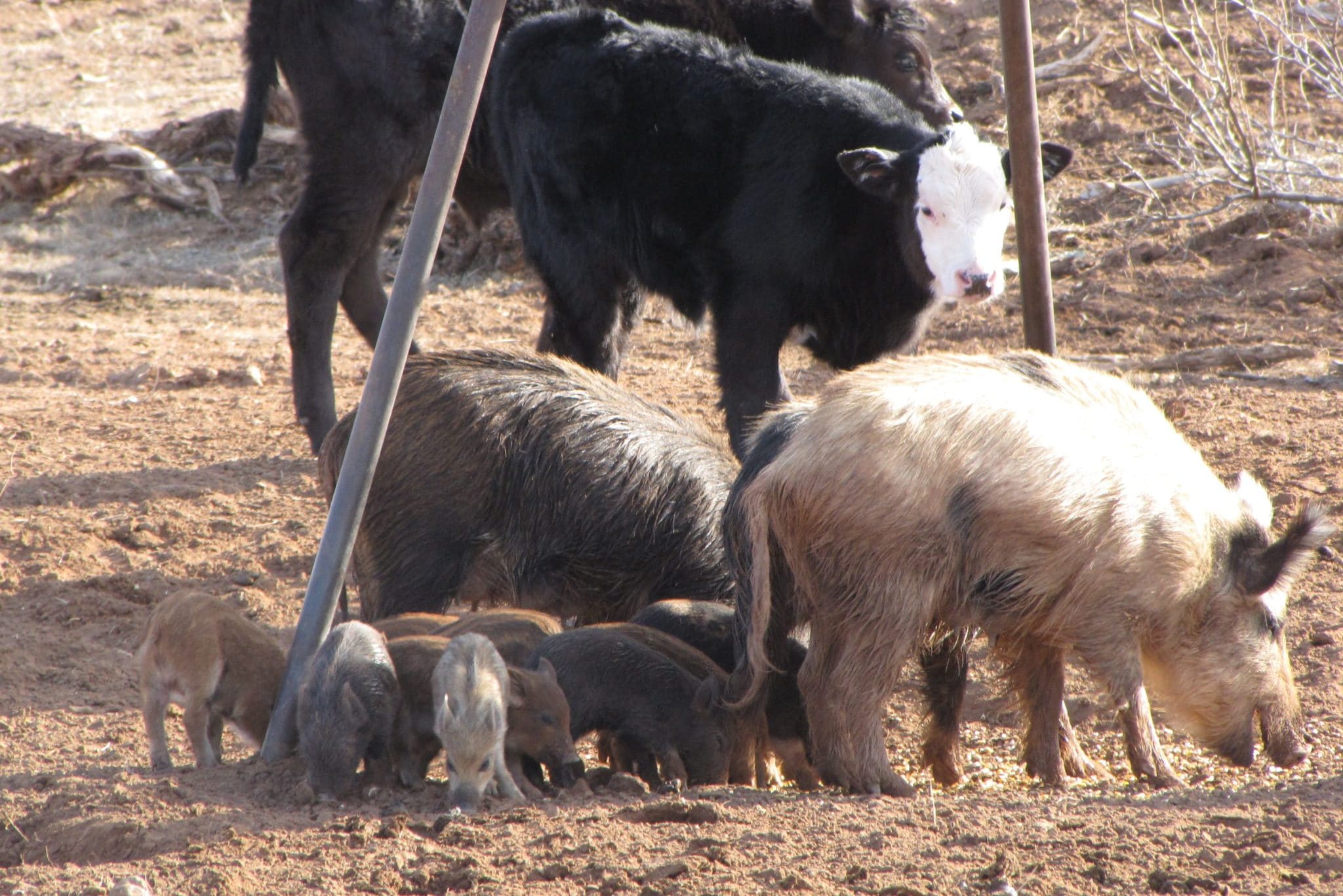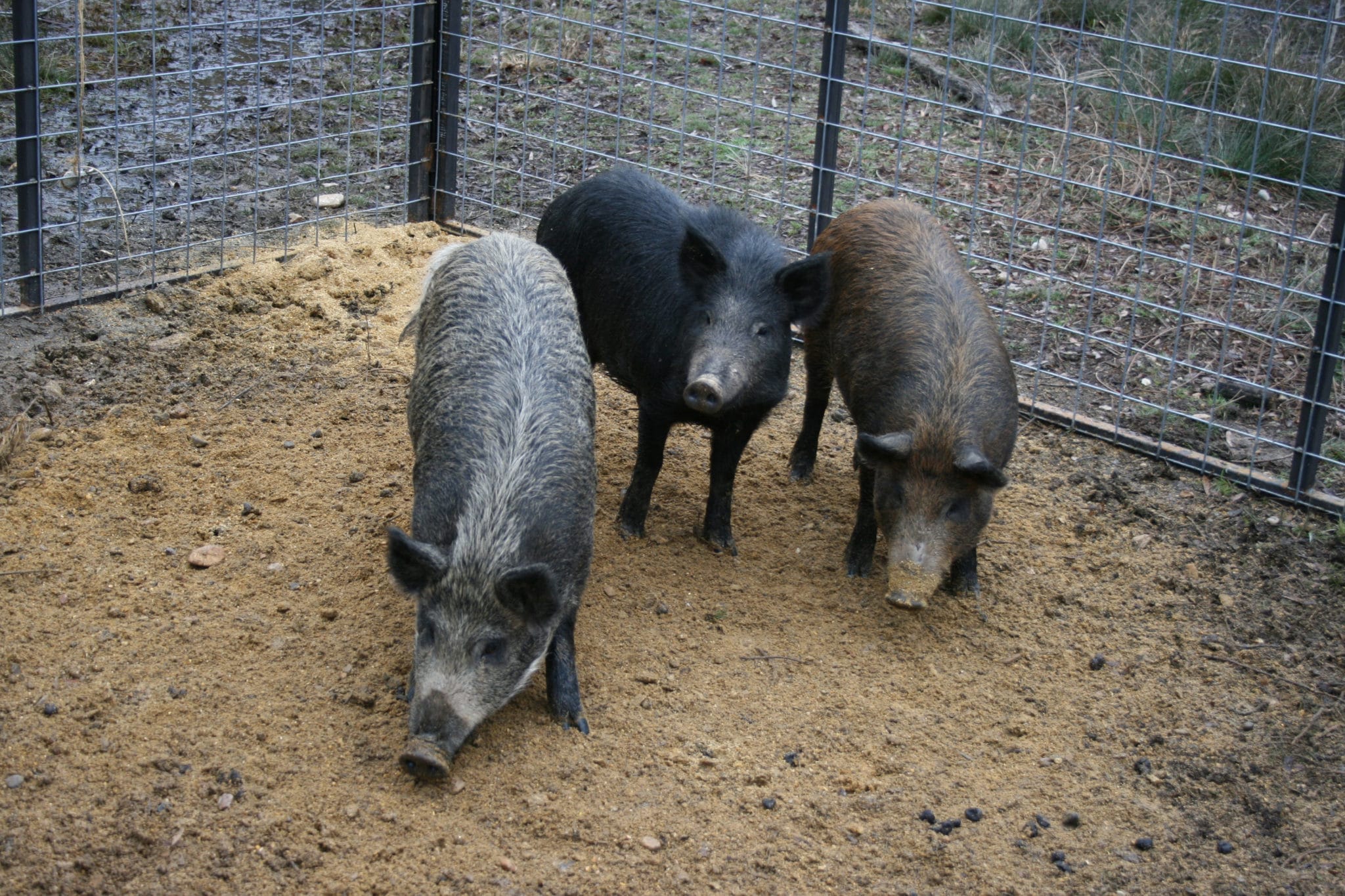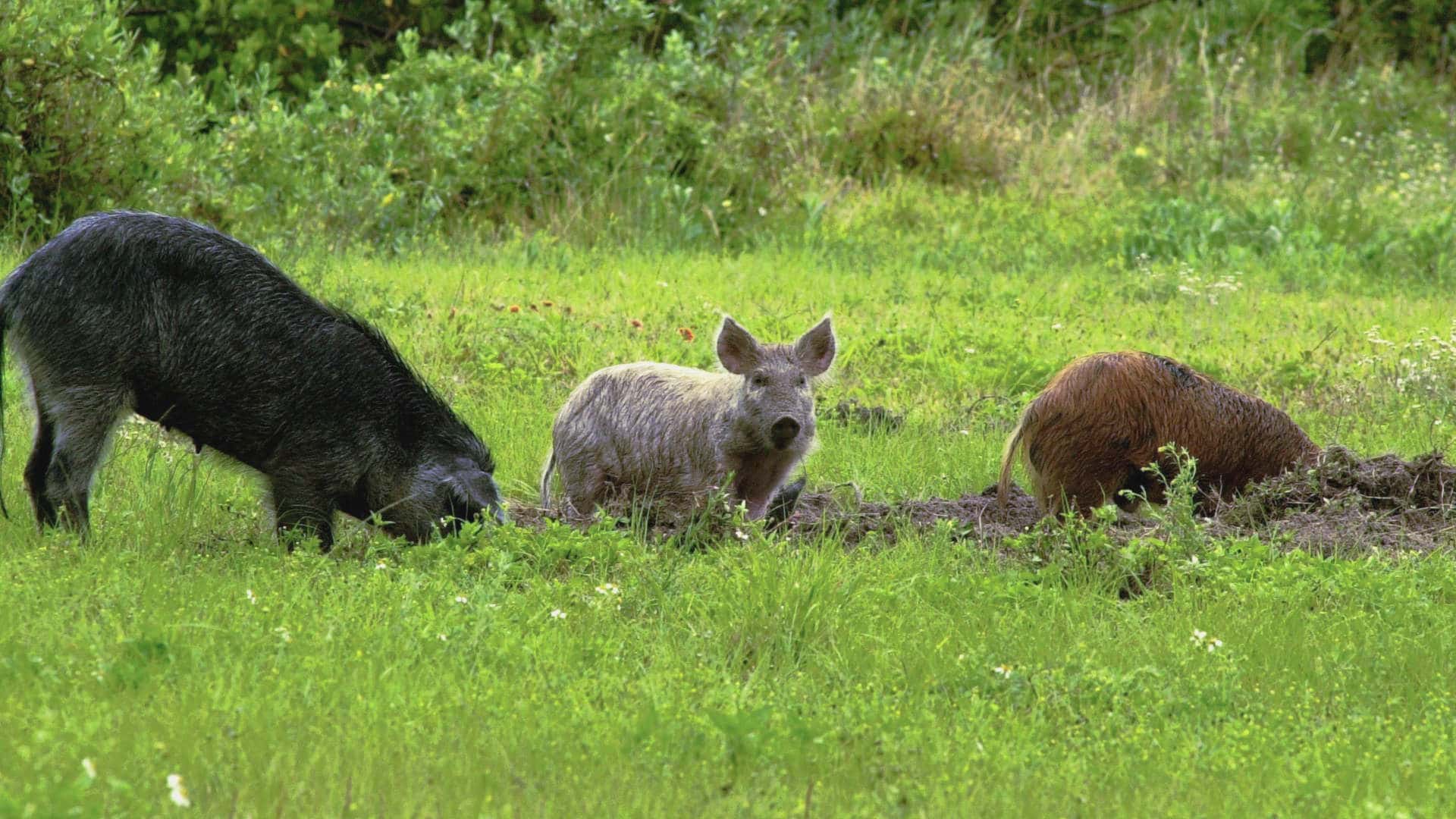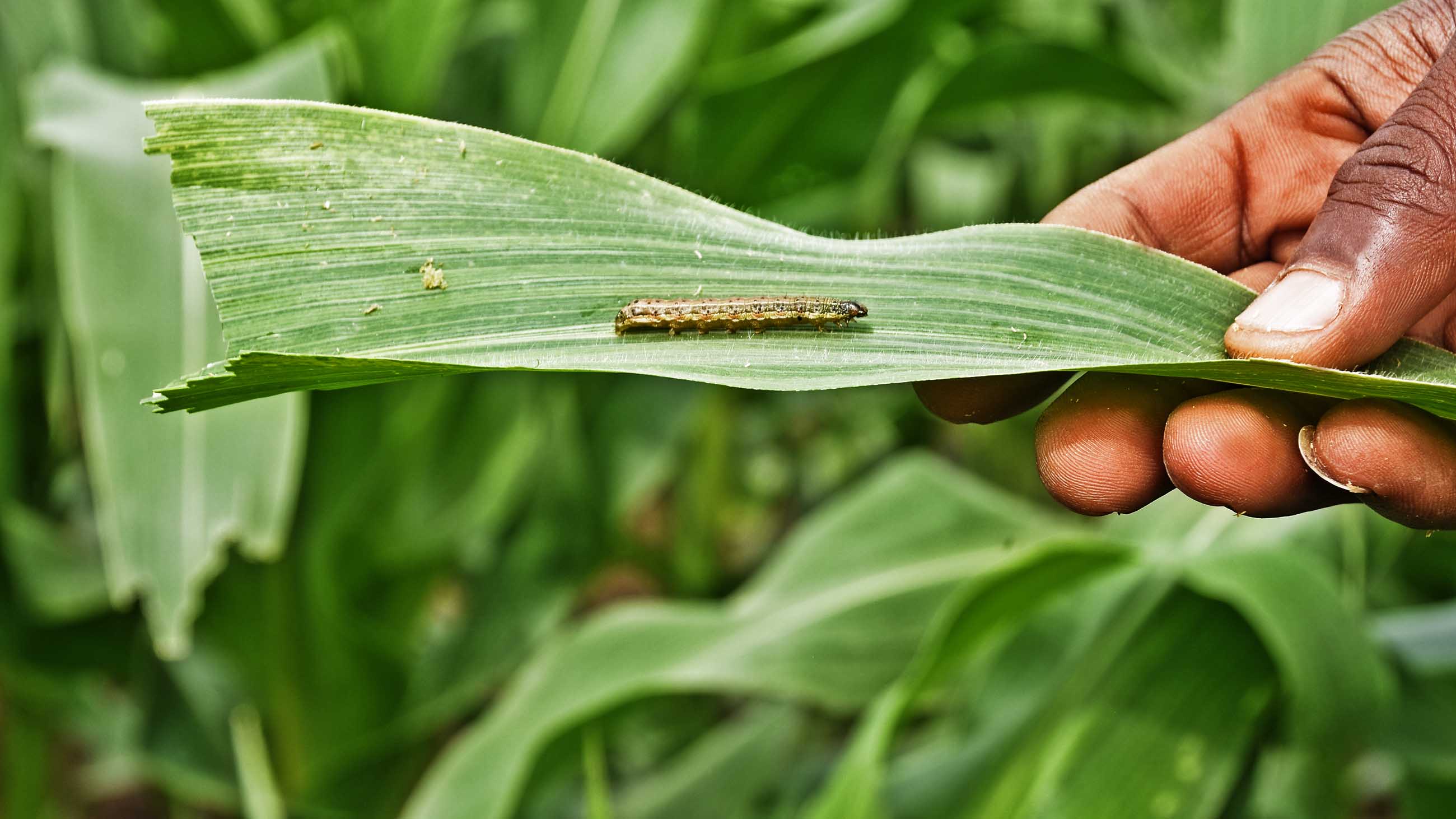The Scramble to Defuse the ‘Feral Swine Bomb’
Nic Peach squinted through binoculars at two dots in the distance, tracking what he assumed were a pair of turkeys. But the creatures were not moving like turkeys, which he was hunting on his grandfather’s farm in Little Britain, Ontario. As they moved closer, Peach could see they were pigs, rooting in the ground. Large, hairy pigs. One of them was massive. “My jaw dropped,” he recalls.
That was the first day of the turkey hunt in spring 2019, and at the time Peach worked as conservation outreach coordinator for the Ontario Federation of Anglers and Hunters, where he’d learned about wild swine, an invasive species that causes economic, health, and ecosystem havoc. He knew it was rare to glimpse these creatures, which are excellent at hiding. He also knew that, counterintuitively, he shouldn’t shoot, as gunfire makes other pigs in the group, called a sounder, flee, and hunted pigs wise up around humans.
There are as many as 9 million feral swine across the U.S., their populations having expanded from about 17 states to 38 over the last three decades. Canada doesn’t have comparable data, but Ryan Brook, a University of Saskatchewan biologist who researches wild pigs, predicts that they will occupy 386,000 square miles across the country by the end of 2020, and they’re currently expanding at about 35,000 square miles a year.
“I’ve heard it referred to as a feral swine bomb,” says Dale Nolte, manager of the National Feral Swine Damage Management Program at the United States Department of Agriculture. “They multiply so rapidly. To go from a thousand to two thousand, it’s not a big deal. But if you’ve got a million, it doesn’t take long to get to 4 [million], then 8 million.”
Most wild pigs are a mixture of domestic breeds and European wild boar. “The problem with the hybrids is you get all of the massive benefits of all of that genetics. It creates what we’d call super pigs,” says Brook. Domestic pigs have been bred to be fertile year-round and have big litters — now averaging more than 10 in each — and also to grow large. (Farmers limit their diets in captivity, but they fatten up when they graze at will in the wild.) Boars, meanwhile, have heavy fur and other attributes that help them brave the winter months. Wild or domestic, the species is highly intelligent with a keen sense of smell.
Over the last few decades, wild pigs in some regions have grown to unmanageable numbers: Texas has about 1.5 million and spends upwards of $4 million annually controlling them, with little hope of eradicating the population. Florida, Georgia, and California also have vast populations. “Pig populations are completely out of control,” Brook says of North America in general. “The efforts to deal with them are about 1 percent of what’s currently needed.” He says that his province of Saskatchewan will soon have more wild pigs than people.
Years ago, preventing feral pig populations hardly seemed worth the money, but today these animals are responsible for an estimated $2.5 billion worth of damage in the U.S. each year, mostly by mowing down farmers’ crops, as well as attacking calves, lambs, and pregnant livestock, and destroying native plants, animals, and precious habitats. A feral pig can host at least 30 viral and bacterial diseases, along with nearly 40 parasites. If African swine fever were to arrive in North America, feral pigs could be pivotal in spreading this devastating and deadly porcine disease.
Two notable places in North America are tapping into new resources to prevent, track, and cull pig populations. The province of Ontario has an emerging population of a few hundred pigs, and is educating the public, collecting data, and testing how to track and remove swine. Meanwhile, the state of Montana, which is currently free of wild pigs, has a snappy public education campaign, support from local groups, and strict laws. “These are the areas where there’s been the greatest response and media attention,” says Nolte.
Both jurisdictions are also relying on wild pig conferences, published studies on topics such as the impact of hunting on wild pigs, and experts who know how to take down a sounder in seconds. “We have better advice now than was available even five, six years ago,” says Nolte.
The question is whether these regions can defuse the pig bomb before it goes off.
Pigs go wild by escaping their farm enclosures. “Any pig outside of a fence is a problem,” says Jeremy Downe, invasive species policy adviser with the Ontario Ministry of Natural Resources and Forestry (MNRF). An offspring from a farmed pig born in the wild will be feral, with tusks — all pigs grow them, but farmers cut them off their piglets — and likely more fur, especially if it’s a hybrid between a native pig and a wild boar.
Wild swine have an average range of as much as 19 square miles. They’ll roam further if someone shoots at them, plus they become nocturnal when hunted, and thus harder to track. While federal and state authorities use aerial shooting to systematically target and kill whole sounders of pigs, when states like California and Texas have encouraged recreational hunting as a way to reduce their pig populations, it has backfired dramatically when surviving animals spread across the state. In some places, for-profit hunting outfits have worsened the problem by importing feral pigs. “It causes problems when people move animals to establish new populations for hunting,” says Nolte.
This is how Montana first became concerned about wild pigs. In 2013, a resident brought in three feral hogs from Texas for a shoot. The Montana Department of Livestock, which had heard about the threat of these animals from other states, found out and had the animals destroyed. The state took the incident so seriously that it passed legislation in 2015 banning hunting of feral swine, as well as owning or transporting them, imposing fine of up to $10,000 on lawbreakers.
In 2018, the state reported a sighting near its border with Saskatchewan and sent up planes to see if the creatures had crossed over — they had not. “That got everyone’s attention,” says assistant state veterinarian Tahnee Szymanski. Her department, the Montana Department of Livestock, partnered with the Montana Invasive Species Council — the former has responsibility for hands-on work while the latter runs public education — and got information from the USDA and other groups to create a collaborative plan.
Last November, Montana hosted the Feral Swine Summit, inviting representatives from the ranching industry, local tribes, and neighboring states. At the same time, it launched an education campaign with the catchy title “Squeal on Pigs” — borrowed from nearby Washington and Oregon — that encouraged residents to call a 24-hour hotline with sightings so staff could trap and kill the creatures.
It’s had reports of potbelly pigs near Billings, which staff rounded up and returned to their owner. Another tip revealed a man who had brought in boars from Texas for hunting. He didn’t know he was breaking the law, and staff killed the still-penned-in pigs. Szymanski says the state has looked into using surveillance tools, if needed, and plans to keep collaborating with nearby states and groups within its borders with a stake in pig control to stay feral pig free. “The goal is to stay this way forever and not have them come in,” says Szymanski.


Ontario has moved more slowly to deal with pigs in the 400,000-square-mile province. “We’re not talking in the thousands,” Downe says of how many wild pigs roam Ontario. Starting in 2018, the MNRF began tracking pigs and informing the public about them. “With all invasive species issues, education is key,” says Downe, who was part of the team that created an information web page with links to report sightings, plus one to the iNaturalist web site, where people can upload pictures and comment. To date, the ministry has had reports of around 400 pigs outside of fences.
After a public education campaign in late 2019, the ministry launched a pilot tracking program with two wildlife technicians doing site visits. They were trained by experienced officials from New York State on how to trap and shoot sounders. “We haven’t had a lot of luck, to be quite honest,” says Downe, likely because most site visits happened months after sightings. The pilot team also put out bait and trail cameras and educated people about feral pigs before it paused work in March because of Covid-19. (It should ramp up again soon.) However, while Peach’s work colleagues reported his pig sighting, no one ever came to check on things, and he never saw the creatures again either.
In April, the ministry made a submission to the Ontario government to have feral pigs officially considered an invasive species in the province, which would open up the possibility for more rules, including banning hunting. “There’s political and stakeholder support for greater action,” says Downe.
Both Ontario and Montana are taking advantage of research and reports by other states and provinces. Szymanski says research in Colorado, for example, found that hunted pigs will up their travelling range to as far as 100 miles — data that convinced it that a hunting ban was key. Ontario has also looked to research, including a 2019 study by Brook that assessed different methods for detecting and mapping pigs.
Ontario has been involved in the virtual 2020 Wild Pig Conference, which ran in June and featured presentations about topics such as using GPS devices to track pigs in Florida and pigs’ impact on wild turkeys. The province is also gaining insights from the new, national steering committee on feral swine in Canada, which had its first meeting in January. Marnie Zimmer of the Canadian Cooperative Wildlife Health Center, who’s heading up that committee, says when regions share information with each other, they find affordable tools: “It’s knowing what works best, and what we can do with the money that we do have, and how we can spend it wisely and most effectively.”
Zimmer and others laud Montana’s prevention efforts. “Montana has done a fantastic job, with their ‘Squeal on Pigs’ campaign and public education and outreach,” she says.
Ontario gets kudos for its commitment to collecting local data and combining it with evidence from elsewhere. “I would give them an ‘A’ for their efforts. They’ve been very practical and smart in how they’ve proceeded,” says Brook, but he also calls the waffling over a hunting ban a “critical error.”
Those who work with feral hogs want to see evidence that early prevention can work to save money and ecosystems. “Twenty years ago, an investment of $300,000 would have been huge in Saskatchewan,” says Brook, who emphasizes the value of mobilizing as early as possible. With other regions across North American at risk of feral swine taking hold — including North Dakota and Canada’s Yukon Territory — evidence that early investments can work really matter. “Prevention is critical in those areas where no feral pigs are established,” says Zimmer. “It’s definitely better to get ahead of the curve.”
UPDATE: The original version of this article incorrectly stated that wild swine have a range of as much as 30 square miles. The article has been updated to the correct figure of 19 square miles.












Comments are automatically closed one year after article publication. Archived comments are below.
I’m in Texas, and I know several folks with farms/ranches, including my wife’s family. While this article is mostly correct, it’s misleading to say hogs have litters of ten. Maybe in captivity, but in the wild it’s about 1½ litters/year with 5-6 piglets per litter. Also, they don’t get larger in the wild. They have to move around a lot to find food, and use up a lot of energy in that endeavor. In over ten years of hunting & trapping, the biggest I’ve seen was just under 300 Lbs. They can get larger, but it’s rather rare. Over 200 Lbs is considered big for a feral hog.
The NOBLE institute developed the BoarBuster overhead trap for this reason.
You trap the entire sounder of swine. Remove and repeat. You can remove over 70% of the population each year which is what is needed to reduce the population.
At the rate Feeders go up in Texas every year, it’s a wonder there aren’t moreally hogs. They are being fed, night and day, on every piece of leased land
Well if they decide hunting is the best solution, they can use the campaign slogan “Go Hog Wild!”
I wonder if bow-hunting has the same effect to drive them to expand their territory. Without the noise of a rifle shot to alert the rest of the sound and scatter them….
If climate change continues apace, we will need to be eating them
Sodium Nitrite poisoning is the only thing that will work. You might kill some native wildlife but oh well. Chemo and radiation therapy kill healthy cells, but we still treat cancer. Feral hogs are a cancer. Large sounders being wiped out by poison bait is the only way eradication can happen.
Be more than happy to help hunt All over USA with pigs but seems like everyone wants to profit from help so suffer as far as I am concerned. Try to help now a days and everyone has their hands out 😡👎🏼